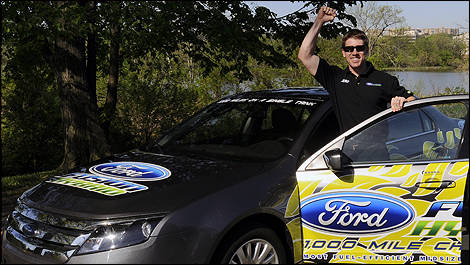At 9:08 a.m. this morning, the US 2010 Ford Fusion Hybrid Challenge team hit the 1,600-kilometer (1,000-mile) mark on a single tank of gas, and is continuing its ultimate fuel-efficiency challenge with nearly one-third of a tank of fuel remaining!
This mark was achieved with the Fusion Hybrid 1,000-Mile Challenge team leader and NASCAR driver, Carl Edwards, behind the wheel. Other team members include world-record breaking hypermiler Wayne Gerdes and several Ford hybrid engineers.
This challenge started at 8:15 a.m. on Saturday, April 25, from Mount Vernon, Va., and is expected to end on Tuesday, April 28 in Washington, D.C.
2,94 li/100 km!
According to the Ford press release, the regular production version of the Fusion Hybrid used in this challenge delivered 2,94 li/100 km (over 80 miles per US gallon) over the course of 47 hours of continuous driving. The team will continue to drive until the fuel tank is depleted.
Ford says this vehicle is being put to the test to demonstrate it's commitment "to be the best, or amongst the best, in fuel economy in every vehicle segment in which it competes". The event is also designed to raise funds for the Juvenile Diabetes Research Foundation in the process.
Mileage-maximizing techniques that the Ford team used and recommend to consumers include:
.Slowing down and maintaining even throttle pressure;
.Gradually accelerating and smoothly braking;
.Maintaining a safe distance between vehicles and anticipating traffic conditions;
.Coasting up to red lights and stop signs to avoid fuel waste and brake wear;
.Minimize use of heater and air conditioning to reduce the load on the engine;
.Close windows at high speeds to reduce aerodynamic drag;
.Applying the "Pulse and Glide" technique while maintaining the flow of traffic;
.Minimize excessive engine workload by using the vehicle's kinetic forward motion to climb hills, and use downhill momentum to build speed; and
.Avoiding bumps and potholes that can reduce momentum.
photo:Ford
 |
| NASCAR Star Carl Edwards celebrates passing 1,600 km (1,000 miles) on a single tank of gas in Alexandria, Virginia, at 09.08 on Monday 27 April, 2009. The car has been running now for 49 hours continuously. |
This mark was achieved with the Fusion Hybrid 1,000-Mile Challenge team leader and NASCAR driver, Carl Edwards, behind the wheel. Other team members include world-record breaking hypermiler Wayne Gerdes and several Ford hybrid engineers.
This challenge started at 8:15 a.m. on Saturday, April 25, from Mount Vernon, Va., and is expected to end on Tuesday, April 28 in Washington, D.C.
2,94 li/100 km!
According to the Ford press release, the regular production version of the Fusion Hybrid used in this challenge delivered 2,94 li/100 km (over 80 miles per US gallon) over the course of 47 hours of continuous driving. The team will continue to drive until the fuel tank is depleted.
Ford says this vehicle is being put to the test to demonstrate it's commitment "to be the best, or amongst the best, in fuel economy in every vehicle segment in which it competes". The event is also designed to raise funds for the Juvenile Diabetes Research Foundation in the process.
Mileage-maximizing techniques that the Ford team used and recommend to consumers include:
.Slowing down and maintaining even throttle pressure;
.Gradually accelerating and smoothly braking;
.Maintaining a safe distance between vehicles and anticipating traffic conditions;
.Coasting up to red lights and stop signs to avoid fuel waste and brake wear;
.Minimize use of heater and air conditioning to reduce the load on the engine;
.Close windows at high speeds to reduce aerodynamic drag;
.Applying the "Pulse and Glide" technique while maintaining the flow of traffic;
.Minimize excessive engine workload by using the vehicle's kinetic forward motion to climb hills, and use downhill momentum to build speed; and
.Avoiding bumps and potholes that can reduce momentum.
photo:Ford


